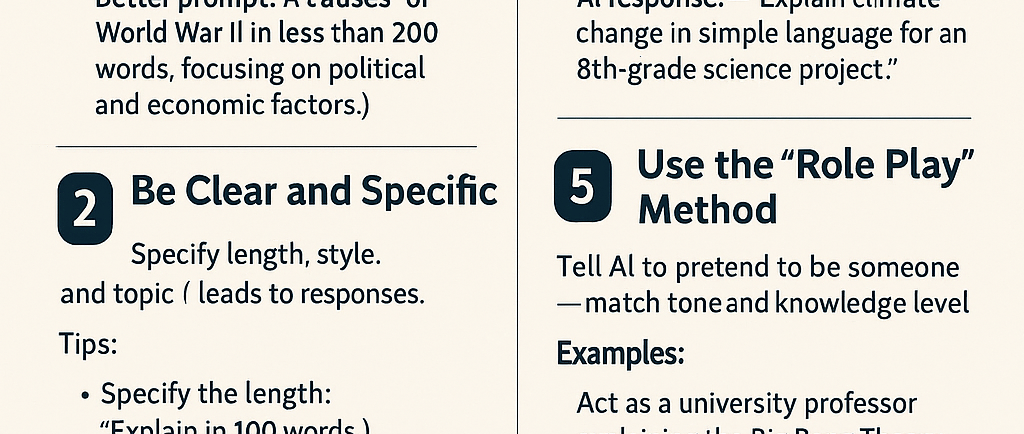How to Master AI Prompts: A Guide for Students


Artificial Intelligence (AI) has become an essential tool for students, from helping with research to generating ideas and organising study materials. One of the key skills for making the most of AI is mastering prompts — knowing how to ask AI the right way to get the best results. Whether you’re using AI to write essays, study for exams, or brainstorm projects, strong prompts can make your work faster, smarter, and easier.
Here’s how students can master AI prompts effectively:
1. Understand What a “Prompt” Is
A prompt is simply what you type into an AI tool to get a response. Think of it like giving instructions: the clearer and more detailed your instructions, the better the AI can help you. Vague prompts lead to vague answers; detailed prompts lead to detailed answers.
Example:
Vague prompt: “Tell me about World War II.”
Better prompt: “Summarize the causes of World War II in less than 200 words, focusing on political and economic factors.”
2. Be Clear and Specific
AI responds best when it knows exactly what you’re asking. If you need a short explanation, a comparison, or a creative answer, say so in your prompt.
Tips:
Specify the length (e.g., “Explain in 100 words.”)
Mention the style (e.g., “Write like a high school student.”)
Focus the topic (e.g., “Describe photosynthesis for a 10th-grade biology project.”)
3. Experiment with Different Styles
AI can adapt to various writing styles and formats if you ask. Need an essay, a bullet list, or a poem? Just include that in your prompt.
Examples:
“Write a persuasive essay about renewable energy.”
“List 5 key facts about the American Revolution in bullet points.”
“Summarize Shakespeare’s Hamlet as a funny poem.”
Practicing different styles not only helps you get better results but also teaches you how to think flexibly.
4. Learn to Refine and Re-Prompt
Sometimes the first answer won’t be perfect — and that’s okay! Good prompting often means refining your question.
Example of refining:
First prompt: “Explain climate change.”
AI response: (Too technical)
Refined prompt: “Explain climate change in simple language for an 8th-grade science project.
Every time you rephrase or add detail, you get closer to exactly what you need.
5. Use the “Role Play” Method
One powerful trick is telling the AI who it should pretend to be. This helps the AI match the tone and knowledge level you need.
Examples:
“Act as a university professor explaining the Big Bang Theory.”
“Pretend you are a professional career coach. Give me resume tips.”
Role-playing helps you get expert-level answers targeted for specific audiences.
6. Combine Creativity and Logic
AI isn’t just for academic tasks — it’s also a tool for creativity. Use it to brainstorm essay topics, invent science fair ideas, or even create fictional stories.
Creative prompts:
“Give me 10 funny ideas for a short story about time travel.”
“Suggest 5 unique science fair project ideas for 9th graders using household items.”
Combining logical structure with creative thinking will make you a real AI pro.
7. Always Double-Check the Information
AI can be incredibly helpful, but it’s not perfect. Always verify facts, dates, and sources from reliable materials — especially for academic work. Think of AI as a smart assistant, not your only source.
Final Thoughts
Mastering AI prompts is a modern superpower for students. With practice, you’ll learn to guide AI with clarity, creativity, and critical thinking. Start simple, keep experimenting, and remember: the better your prompt, the better the AI’s answer .
Practice every day, and you’ll soon be using AI like a pro!
